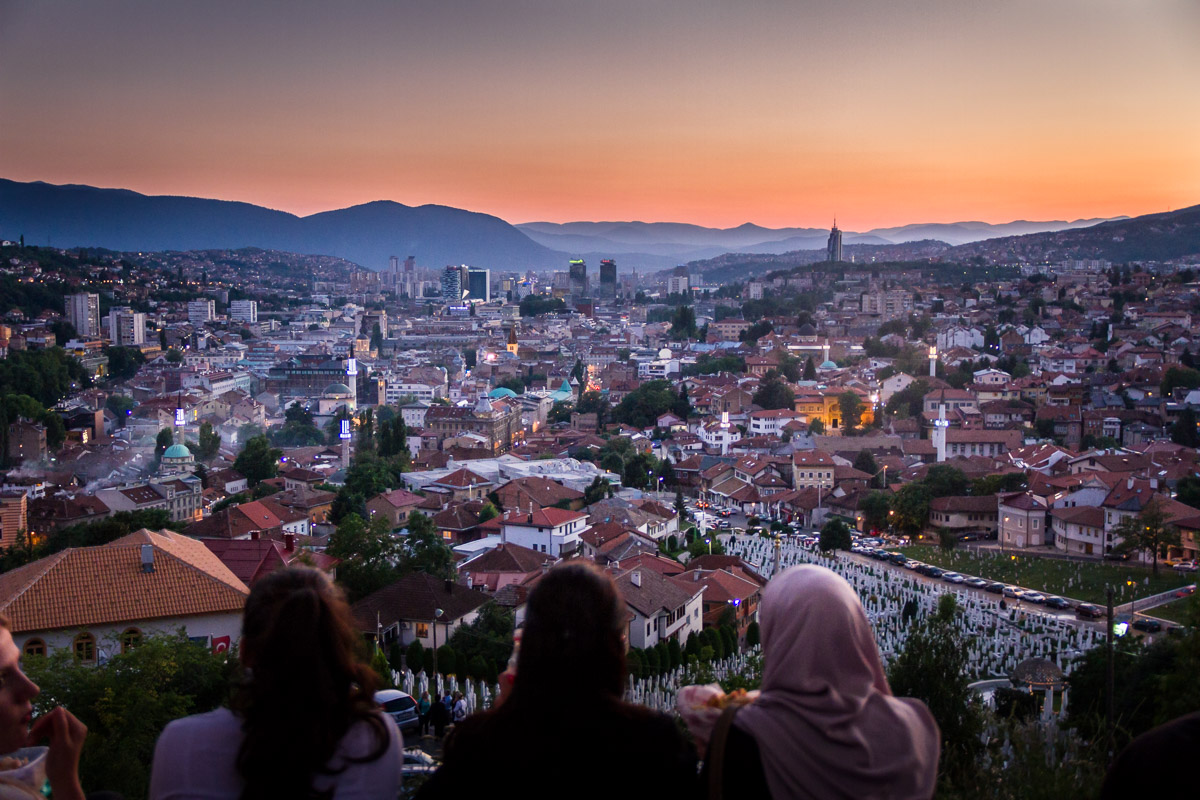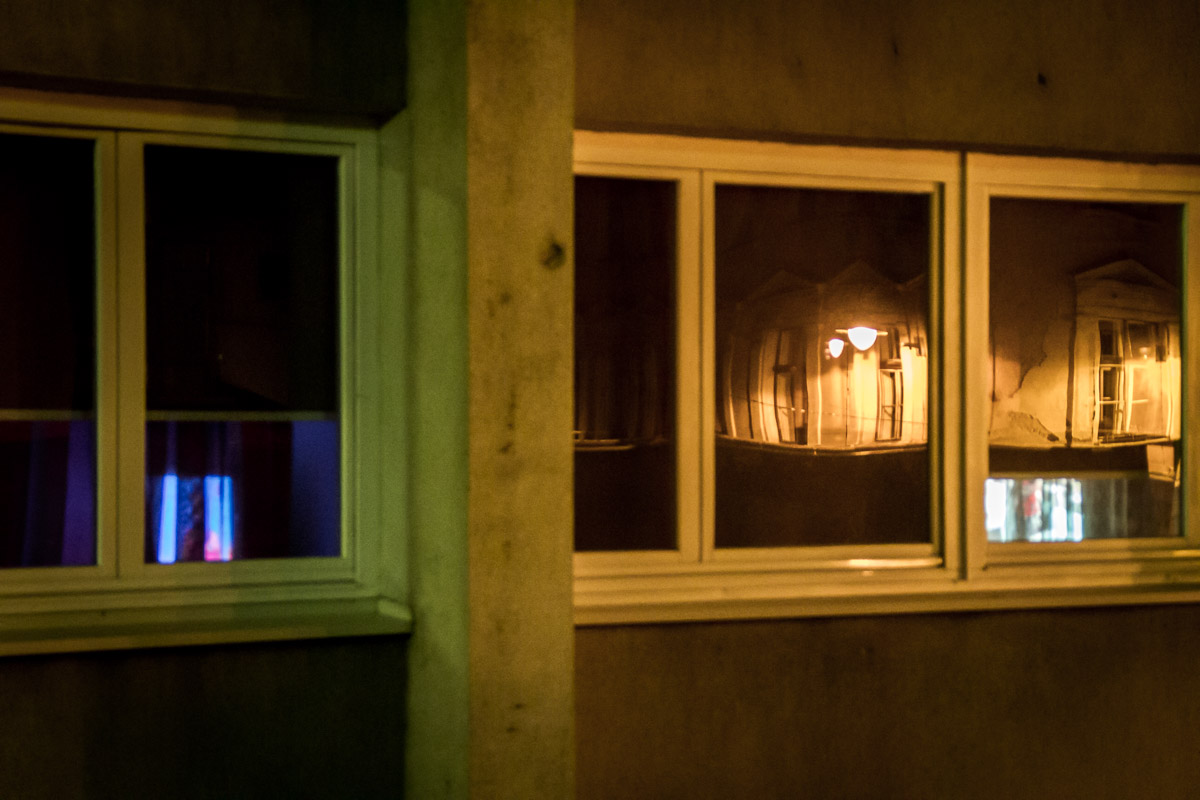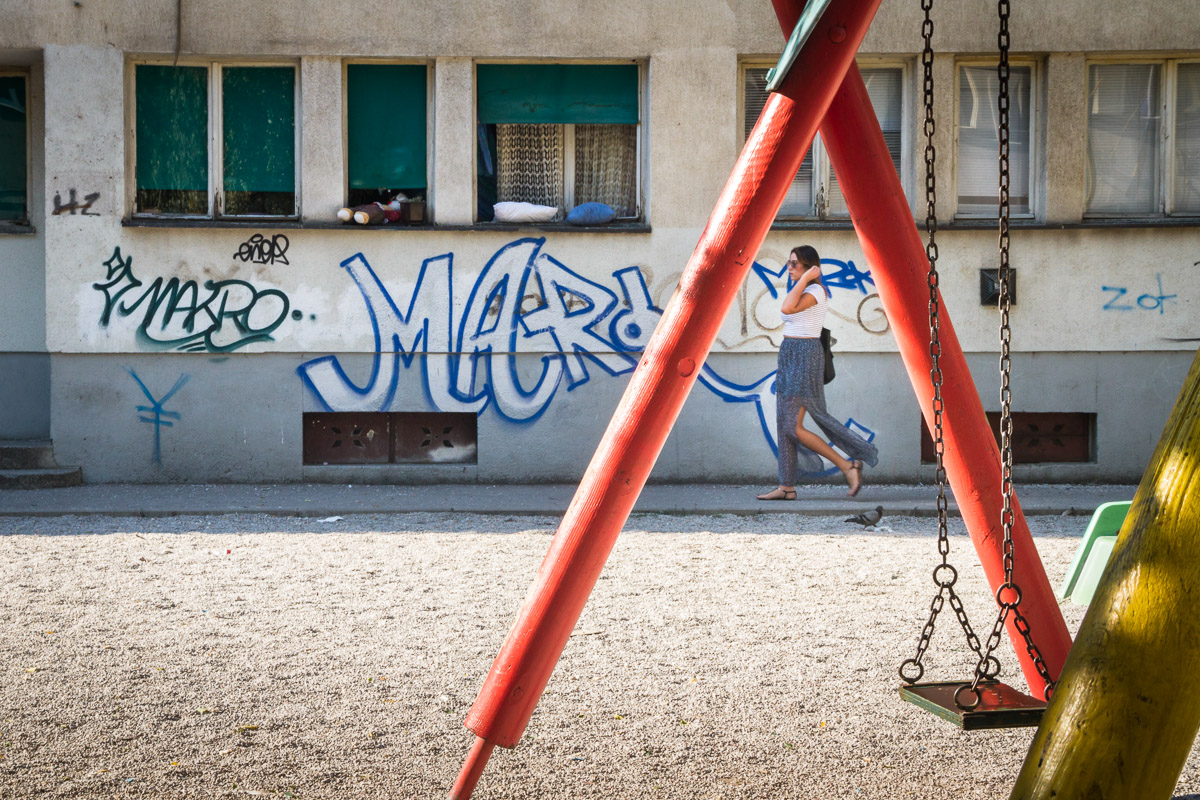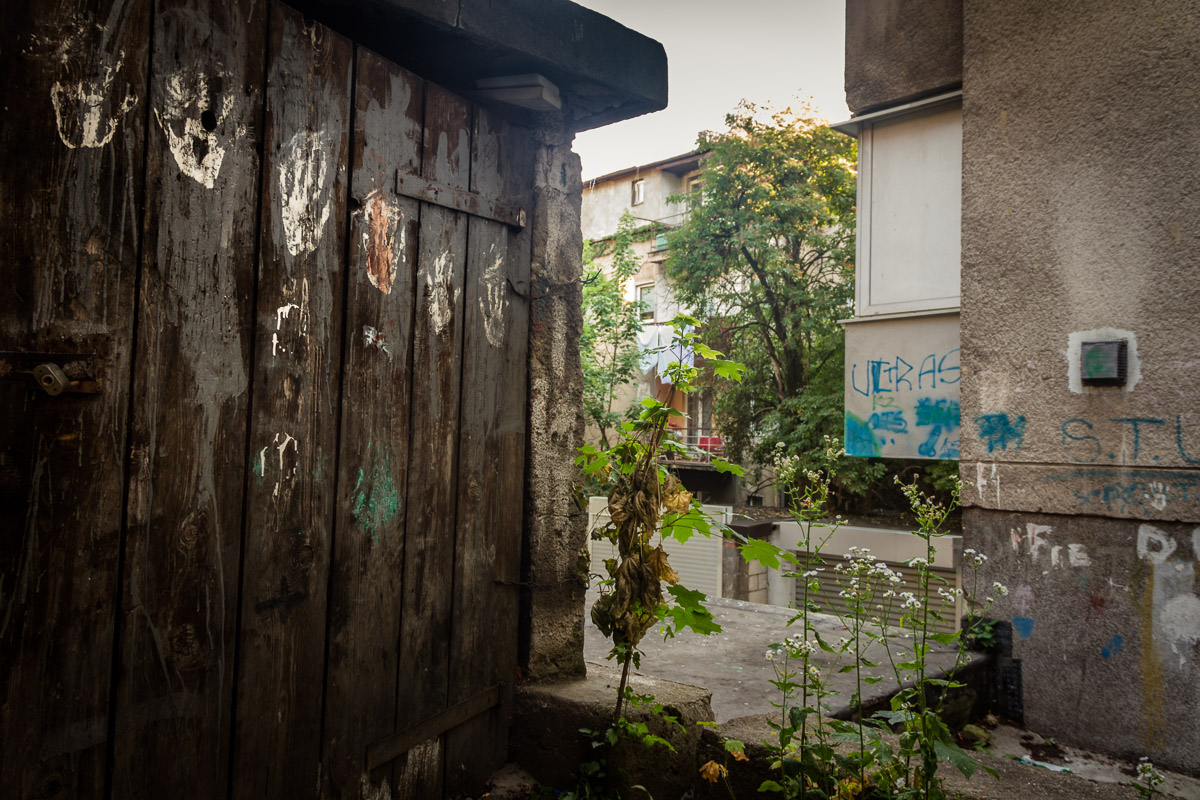SARAJEVO – A walk in the everyday life
DAY#1. The journey.
The day starts early in the morning in Gorizia, at the border with Slovenia, and continues through the latter’s windy and sunny countryside. I have already been in the inner regions of the Balkans a few times before but only while in transit, and only for a few hours. Beautiful people, cultures and landscapes; unique experiences which left me bewitched and with a sense of longing once back home. In a way, this trip feels like a long awaited homecoming, a cure for nostalgia.
Slovenia is a rather small country and by the early afternoon I am already speeding through the flat landscapes of central Croatia under a pale and overcast sky. Travelling by car allows for a slow and relaxed pace. It emphasises and gives you the chance to appreciate the many details of the gradual transition from the busy and saturated anthropic landscapes of Western Europe to the austere and rural Eastern European countrysides. The journey becomes a slow-motion dive into a new world; a liberating experience from the oppressive full-blown consumerism of the European capitals.
A few hundreds kilometres later and as the clouds begin to open up again revealing a stunning red sunset, I enter Bosnia-Herzegovina. As the scenery starts to turn wilder, sporadic stops at gas stations and inns along the way also remind me of one of the most eloquent and peculiar trait of this region: language. Coming from Romance Europe, the Slavic dialects of the Balkan region feel unfamiliar and cryptic to my ears; almost intimidating with their distinct cadences and sounds, yet so intriguing and charming.

Due to the rugged geography, the consequences of the recent war and the ongoing economic crisis, the highway network in Bosnia-Herzegovina is still work in progress. So, from the Zagreb-Belgrade interstate, legacy of the Titoist era, the county road becomes the only way to reach Sarajevo. In a sense, this inconvenient further enhances my slow-travel experience, allowing me to build an even more intimate relationship with this new place, while studying the local interactions between human and nature from up close.
As the road twists and turns through the steep river valleys, I come across villages consisting most of the times of just a handful of small buildings and family-owned businesses. Small two-levels detached houses constitute the typical kind of accommodation in this part of the Balkans. With their pointy tiled roofs and the unfinished look given by the structural brickwork and woodwork left exposed and unplastered, they appear rather plain and humble. In the meantime, the slender profile of minarets entirely lit for the holy period of the Ramadan begin emerging from the darkness of the night like lighthouses, quietly highlighting the transition to the Islamic side of Europe.
From the mountaintops around Sarajevo I begin to see the city lights, while I become overwhelmed with joy and excitement as I have arrive in town and I can finally rest. The last stop of a one-day journey across the northern Balkans; a conscious approach to my destination. A process which has allowed me to gradually work out the transition between Western and Eastern Europe, filling all the gaps of such a radical change in perspective. Now, as I step out of the car and stretch my legs to find something to eat, everything seems already so familiar.
DAY#2. De-constructing expectations.
In terms of government, Bosnia-Herzegovina is a rather decentralised country. It is made up of two main autonomous entities: the Federation of Bosnia and Herzegovina, and Republika Srpska. The former, further organised in ten cantons, is mainly home to Bosniaks (Muslim Bosnians) and Croats, while in the latter Serbs represent the prevalent ethnic group. This ethnic partition largely reflects the religious composition of the country, with half of the Bosnian population being of Islamic faith, and Serbs and Croats being respectively Orthodox and Catholic Christians. Among the other religious groups, the Bosnian Jewish community also represents an important and deeply rooted historical presence although small.

Sarajevo is located in the South-Eastern part of the country where the Bosnian Federation and Republika Srpska meet at the feet of Mount Trebević and the Dinaric Alps. This small and compact city, lies along the valley of the Miljacka river and is home to about 430.000 people in its urban boundaries. A lovely and warm place where to spend the summer and a snowy and magic city in the winter.
As I wander around the Bistrik neighbourhood, the area where I will be based for the next few days, I start to experience Sarajevo in its authenticity and I find myself questioning the mental image I carry of this town. Prior to my departure I did not have the time or chance to plan or research anything in advance, therefore now everything looks quite new and different from what I had pictured in my mind.
I begin noticing all the differences between reality and expectations; constructs I had built through the years on high school history books or occasionally watching documentaries about the Bosnian War. Lost in the streets and alleys of the old town I feel like a guest in someone else's home; stranger in a context in which I need to get comfortable and accustomed, but also very welcome. A situation which becomes somewhat quick to overcome, facilitated by the open-minded attitude and friendliness of the local people, probably more used than me to live in a multi-ethnic environment.

Indeed Sarajevo is considered a model when it comes to integration and coexistence of peoples. Although Islam has increased its presence since the end of World War II and the Yugoslavian Wars, the capital has always held high its cosmopolitan character. A crossroad of cultures and meeting point between Orient and Occident for which it is known since the Ottoman period as the “Jerusalem of Europe”. Therefore feeling at home is easy here, and the size of the city certainly helps in this regard. Nothing to do with the vast and chaotic cityscapes of our Western-European capitals. In Sarajevo everything is human-sized and at walking distance even though the public transport might not be as efficient as that of Paris, Berlin or London (however much it may actually be).
But what strikes me the most is the inaccuracy of my constructed image of Sarajevo as a Western-looking city: full of modern buildings, lot of traffic, flocks of tourists and busy people hurrying on the streets in a tireless routine from home to work and back home. What I was expecting to find was a European outpost in the Balkans and a touristic stronghold in a forgotten part of the world; what I have found is none of that.
DAY#3. The scent of Sarajevo.
From the city centre to its suburbs, Sarajevo has grown and expanded through the centuries in horizontal layers like the rings of a tree trunk. From the Ottoman empire, the Austro-Hungarian kingdom, to the Socialist era, each administration has left its own imprint on the town's architecture and personality. Moving westwards from the city centre, this can be easily noticed in the buildings bearing witness this passage of time, today masterfully integrated by the more contemporary and post-Yugoslavian designs.

The Ottoman domination has been fundamental to the town as it appears today, not only for its visual contributions but also for the development of Sarajevo as a crucial node in the trading routes of the Balkans. After arriving in 1461, the Turks were able to transform a cluster of villages into a key town at the heart of the Balkans, a gateway between East and West. Their long lasting legacy can today be admired in the Baščaršija neighbourhood, historical and cultural centre of the city.
In the square of the same name you can find the Ottoman-style Sebilj wooden fountain, few steps away from the 1531 Gazi Husrev-Beg mosque with its 45 metres tall minaret, and the old lunar clock tower. From here tens of alleys branch off into the old bazaar, allowing you to dive in the Oriental heart of the city. The bazaar is a thriving marketplace, where old traditional crafts are still practised by master artisans in their little and characteristic workshops. Here the sound of the repeated clinking of the chisel engraving the copperware becomes the background to the smell of spices, coffee and local food. Alongside workshops and little shops selling traditional souvenirs, cafés and bistros offer local typical food and Turkish coffee. Here, tourists often find themselves sharing these spaces with residents dressed in traditional clothes smoking shisha and talking business or just relaxing, while eating their lunch of Bosnian ćevapi and burek.
Chasing the scent of Sarajevo through its narrow and busy alleyways leads you to discover the town in all its intimacy. Intrigued by its hidden treasures, I soon start slipping through gates and doors, eventually ending up in hidden squares and courtyards. Away from the more touristic areas, this is where you can find the finest handmade carpets and tapestries, hand-decorated traditional silverware; the best spices, herbs and all kinds of seeds and dry goods, traded by skilful and expert hands in fascinating displays of gestures and negotiations.
As I resurface to the main road, I begin to walk uphill from the old Gazi-Husrev Beg vaulted market, passing again by the Sebilj fountain, and through the monumental cemetery. While the Sun sets behind me, I reach the ruins of the Žuta Tabija (Yellow Fortress), a defensive bastion built in 1729 by the Ottomans. Here I attend the firing of the cannon that breaks the daily fasting during the holy period of the Ramadan. While locals celebrate eating their packed dinner with friends and families, I enjoy the sight of the whole Sarajevo skyline wrapped in blue and orange shades, while the chant of the Muezzins starts echoing all over the valley creating a fascinating atmosphere.
As night falls and the lights begin to switch on, the city takes on a completely different personality. Sarajevo’s traditional markets and bazaars give now way to their younger, partying and Occidental-like counterpart. The historical buildings and ancient architecture take on new life with astonishing and very carefully designed light effects. The bars and clubs located in the Austro-Hungarian Marijin Dvor neighbourhood in central Sarajevo become the focal point for the city’s night life, a catwalk for the unique Bosnian sensuality and elegance.

Finally, when it gets too late the city goes to sleep. The day-time busy and noisy streets empty out as Sarajevo slowly falls quiet. Only a cool breeze and the gentle flowing of the tireless Miljacka break the delicate silence of the summer night, giving life to a suggestive and enchanted cityscape. The flowing water becomes a canvas on which the town's artificial lights reflect and distort. Only artificial life now fills the streets: the repeating slow clacking of a broken air conditioning-unit, the clicking of the street lamps, the meaningless alternating of the traffic lights at empty crossroads. Coming down the hillside, I can make out every now and then the glowing of TV screens in the intimacy of dark rooms.
But soon the morning light starts to brighten up the sky above the mountains, and Sarajevo gradually wakes up again to its routines and everyday life.
DAY#4. The Socialist era.
Even though it is August, the morning air feels pleasantly crisp on my skin. Walking along the southern river bank, I enjoy the showcase of Austro-Hungarian architecture: the Sarajevo City Hall and National Library, the Academy of Fine Arts, the Central Post Office, the National Theatre, and the Sarajevo University main building. Similarly, a long series of bridges stretch over the river, built in the most different styles, from Ottoman, to Modern and Contemporary.
From the Markale open air market, I end up in the upper part of the Mejtaš neighbourhood. This residential neighbourhood built on the Sarajevo’s northern hill-side is characterised by typical 1960's working-class buildings. By this time of the day, all the noisy and busy traffic has glided downhill towards bigger avenues such as Maršala Tita or Alipašina, leaving this part of town quiet and pleasantly still. While roaming this maze of steep and narrow streets, from time to time I come across elderly people on their way to run errands, or just sitting on side-street benches smoking the pipe or reading the morning newspaper. From behind the curtains of the open windows, the everyday life of Sarajevo seeps out in the form of – or rather in the acoustic shape – clattering silverware, a loud TV set, someone signing along a radio tune.


While I keep walking, I notice a small playground in a courtyard in the shadow of the surrounding blocks. Full of trees and bushy grass, I find here little kids painting a small wooden shed with the shape of their hands. Just few steps away, some others play on old fashioned but brightly coloured swings and slides. The soft tweeting of the birds, the wind rushing through the tall poplar trees and the peaceful atmosphere, somehow compensate with the melancholic look of the peeling concrete walls still bearing the scars of the war.
The more I explore and dive into the daily life of Sarajevo, the more the city shows me its most private aspects, slowly establishing a series of personal connections. Everything becomes so familiar although so far from home, bringing back memories of my small Italian hometown. With every step I take, I can recognise the sounds and visual patterns also typical of my village, which eventually help me making me feel at ease in this new environment.
As I walk back towards the financial district of the city and the middle of the valley, I pass by the Skenderija Centre, remnant of the golden years of the Socialist period and unperturbed witness of the evolution of the city. Built in 1969 as a cultural, trade and sports centre, it became one of the main venues during the 1984 Winter Olympics. Since then, the building and its surroundings have become a relic of that era, a nostalgic reminiscence of what life was just ahead of the fall of Yugoslavia and the beginning of a 4-years-long siege.


Today, this place looks eerie in its size, architecture and desolation. The pavement of the vast pedestrian areas, worn out and shattered by the relentless passage of time, has become a place for resting for the many stray dogs of Sarajevo looking for a quiet spot. Only a handful of the tents of little shops and businesses that once populated the multi-level trade centre are today still open. Among the rows of rusty shutters and broken front-shop windows, they emerge as frozen in time and space as they must have looked 20 or 30 years ago. Bored and dejected youths have taken over pretty much all the rest of the venue, contributing to its deterioration and decline.
DAY#5. Long live Sarajevo!
Standing approximately across the river from where the Skenderija Centre is located, the high rise buildings of the financial heart of Sarajevo stand out against the surrounding brutalist architecture. Once again, past and present meet here following a common thread that links the Socialist heritage with the contemporary era and the future that is to come. In a matter of just a few hundred meters you can find the Avaz Twist Tower (built in 2008 and currently the tallest building in BiH), and the UNITIC World Trade Towers. The latter colloquially nicknamed Momo and Uzeir after two local radio characters – a Bosniak and a Serb – have became a symbol of resilience after they withstood and survived major shell damage during the recent war. Close by, the Sarajevo City Centre represents a Western-style state-of-the-art shopping mall and leisure complex, including stores of international clothing brands, a two floors entertainment centre, restaurants, and a five stars hotel. Not too distant stands the BiH government building, also heavily damaged during the war and reconstructed between 2005 and 2007 and yet another symbol of the city’s post-war rebirth. On the other side of the long and wide Dragon of Bosnia boulevard, infamously nicknamed Sniper Alley during the years of the siege, stands the iconic and former Holiday Inn building in all its emblematic 1984 Modernist design.

The consequences of the war have been terrible and the economic crisis is not making things any better. After more than twenty years from the end of the conflict, Bosnia-Herzegovina is still struggling, impeded by the setbacks of the recent economic recession. While many people are hit by homelessness and unemployment, corruption and favouritism are widespread. However, younger generations actively push to overthrow these conditions as the “2014 Bosnian Spring” movements have demonstrated in the capital and across the country. A strong reaction not only aimed at restoring Sarajevo as a financial capital picking up from where the war abruptly interrupted, but also as a cultural and social reference point in the whole Balkans.
This part of Sarajevo is where the future takes shape but also where the imprint of such change reflects and distorts the local soundscape. Here the characteristic musical features of the bazaar or those of the residential districts drown in the constant background noise of the traffic. The few distinctive sounds that manage to overcome this incessant drone become in this context either misplaced, such as that of the tolling bells of the Saint Joseph’s Roman Catholic church; or reinforced, belonging to the same set of contemporary and imported sounds of the capitalist and bourgeois society.
Finally, this part of Sarajevo in many ways is the last stop of a journey still under development. Metaphorically it symbolises the city’s stepping stone towards the future, the departing point for tomorrow’s Sarajevo on its timeline. Likewise, it represents for me just another stage of an enriching experience which has changed my way of seeing, hearing and feeling places and people. It has established a series of special and invisible links with my personality, which are not to become the end of a journey but the beginning for what’s to come.

